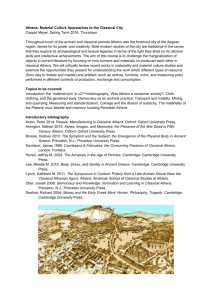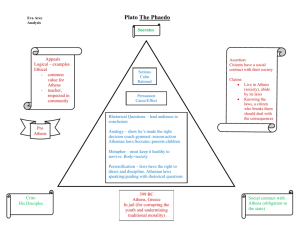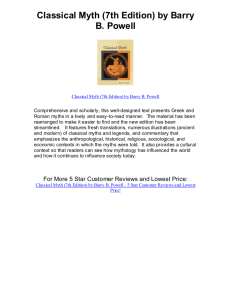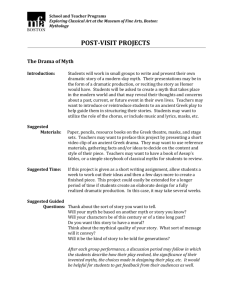Minor 1 Abigail Minor -- Essay To begin my research I started by
advertisement
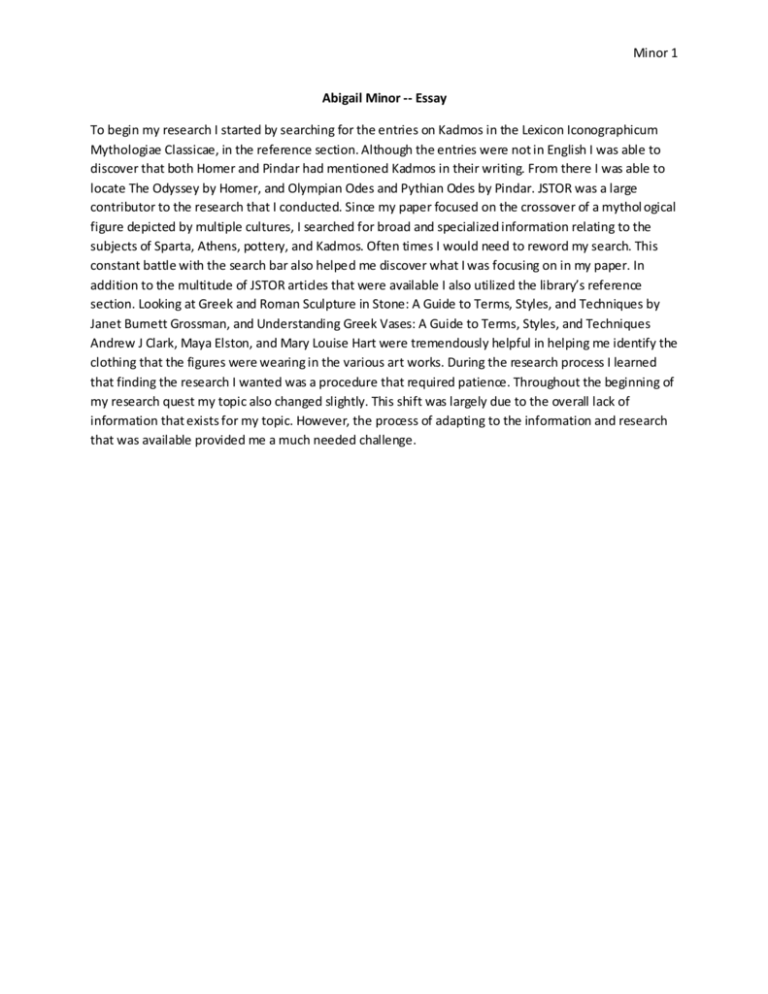
Minor 1 Abigail Minor -- Essay To begin my research I started by searching for the entries on Kadmos in the Lexicon Iconographicum Mythologiae Classicae, in the reference section. Although the entries were not in English I was able to discover that both Homer and Pindar had mentioned Kadmos in their writing. From there I was able to locate The Odyssey by Homer, and Olympian Odes and Pythian Odes by Pindar. JSTOR was a large contributor to the research that I conducted. Since my paper focused on the crossover of a mythol ogical figure depicted by multiple cultures, I searched for broad and specialized information relating to the subjects of Sparta, Athens, pottery, and Kadmos. Often times I would need to reword my search. This constant battle with the search bar also helped me discover what I was focusing on in my paper. In addition to the multitude of JSTOR articles that were available I also utilized the library’s reference section. Looking at Greek and Roman Sculpture in Stone: A Guide to Terms, Styles, and Techniques by Janet Burnett Grossman, and Understanding Greek Vases: A Guide to Terms, Styles, and Techniques Andrew J Clark, Maya Elston, and Mary Louise Hart were tremendously helpful in helping me identify the clothing that the figures were wearing in the various art works. During the research process I learned that finding the research I wanted was a procedure that required patience. Throughout the beginning of my research quest my topic also changed slightly. This shift was largely due to the overall lack of information that exists for my topic. However, the process of adapting to the information and research that was available provided me a much needed challenge. Minor 2 Abigail Minor Myth and Ancient Art Paper #4 The Complexity of Kadmos The myth of Kadmos is one of a virile Phoenician young prince compelled by the gods, to confidently stride into an unknown land, conquer the larger-than- life dangers, create Thebes as his own city, and be remembered throughout history as a legendary founder. Much like Theseus and Perseus, Kadmos travels from his home and overcomes a mythical being that demonstrates his prowess and right to be a ruler. Similar to other hero myths, Kadmos followed a certain formula for success designed to settle the land and find fame. Kadmos captured the attention of the Athenians and the Spartans. These two different vases illustrate the relationships between both the Spartans and the Athenians with Thebes, a fascination with foundational myths, and innovations in vase painting from the Archaic Period to the Classical Period. The Spartan and Athenian reasons for importing the Kadmos myth were specific to the political and cultural atmosphere‟s surrounding each city-state. Franz Kiechle asserts that in the thirteenth and tenth centuries there was a “great decrease in populations in Inner-Lakonia and [an] increase in population at Epidauros Limera on the east coast of Lakonia.” 1 This large migration of people into Epidauros Limera would have affected the cultural sphere that already existed in that land. Since the Kadmos myth, embodies the idea of a foreign power conquering and resettling the land, the Spartans could have grasped this myth as a way of coping with the invasion of land around their territory and their established lifestyle. However, the Spartans could have been looking at what happens when Kadmos slays the dragon. After the killing, Kadmos plants the teeth from Ares‟ dragon, from which warriors, the Spartoi, spring from the ground. A battle between Kadmos and the Spartoi ensues until there are 1 Franz Kiechle, “Sparta and Lakonia: A Regional History 1300 – 362 BC,” The Classical Review, Vo lu me 31, No. 1, (1981): 80 Minor 3 only five Spartoi left, at which point they ally themselves with the conqueror, Kadmos. Since these warriors are in a sense an offshoot of Ares they retain a war- like disposition although they are overcome by a single man, a details that emphasizes the warrior skill of Kadmos. The Archaic Laconian black figure lakaina retains the Spartan style, the figure is in a dramatic profile position and the image embellished with multiple animals. The scene also is full of action since it is the moment when Kadmos, presented as a tradition looking warrior, faces the dragon of Ares. This lack of change in the Laconian style allows the art to still specifically be Laconian even though the subject matter is imported from other people. In contrast, the Athenian relationship with Phoenicia rested on a long period of “mutually beneficial and culturally formative competition and exchange” which would have aided the Athenians‟ interested in the originally Phoenician Kadmos and allowed them to have more access to the story. 2 While a simple explanation, Francis Vian asserts that the Kadmos myth was brought to Phoenicia by Thebans: “Theban emigrants to Ionia carried the fame of Cadmos to the northern and eastern Aegean. And between 650 and 550 he was incorporated, probably at Miletus, in the Phoenician genealogy of Agenor, Phoenix, and Europa.” 3 Although Kadmos could have been “invented to prove the autochthony of the Thebans” it ended up aiding the 2 Jennifer M.S. Stager, “‟Let No One Wonder at This Image‟: A Phoenician Funerary Stele in Athens” Hesperia: The Journal of the American School of Classical Studies at Athens, Vo lu me 74, No. 3, (July-September 2005): 428. 3 Hugh Lloyd-Jones, “Cadmus and the Spartoi” A Rev iew of “Les orig ins de Thebes: Cad mos et les Spartes” by Francis Vian. The Classical Review, New Series, Vo lu me 15, No. 3, (December 1965): 322. Minor 4 Phoenician rulers and spreading their influence. This adaption of the Theban hero into the Phoenician ruler mythology is significant because it shows the powerful influence that Kadmos was able to achieve while also showing how this adaption influenced Attic art. 4 However, Homer makes a point in the Odyssey to not name Kadmos as the founder of Thebes. Instead, Homer assets Kadmos as the father of Ino and names the local Theban twin heroes Amphion and Zethos as the founders: “The next I saw was Anitope, the daughter of Asopus, who claimed to have slept in the arms of Zeus. She had two sons, Amphion and Zethos. They found Thebes, the city of Seven Gates. And walled around it, for all their prowess they were unable to inhabit so vast a city unfortified”(Hom.Od. 263-265). In these lines Homer completely removes the presence of Kadmos in the Theban founding possibly because he did not want a foreigner given the credit of discovery. However, Pherekydes of Athens believed that the twins built the foundation of the city and that Kadmos arrived later to find what they had built and claim it as his own: “Thebes was built (or walled) by Amphion and Zethos as a defense against the Phleyes and that Kadmos came to Thebes later, in a period when the city was desolated.” 5 In regards to pottery, Thebes, being in such close proximity to Athens, imported Attic pottery so illustrating the founding myth of Thebes could have been economically favorable for the Athenian potters. 6 Scenes of heroes in action also was a motif that Attic potters were accustom to creating, so Kadmos would not have been particularly unusually or difficult. On the Classical calyx-krater, Kadmos would have been a recognizable image since the myth had gained 4 Hugh Lloyd-Jones, “Cadmus and the Spartoi” A Rev iew of “Les orig ins de Thebes: Cad mos et les Spartes” by Francis Vian. The Classical Review, New Series, Vo lu me 15, No. 3, (December 1965): 323. 5 Daniel W. Berman, “The Double Foundation of Bo iotian Thebes,” Transactions of the American Philological Association, Volu me 134, No. 1 (Spring 2004): 4. 6 Brian R. MacDonald, “The Emigration of Potters fro m Athens in the Late Fifth Century B.C. and Its Effect on the Attic Pottery Industry,” American Journal of Archaeology, Vo lu me 85, No. 2 (April 1981): 165. Minor 5 popularity and could have passed on inspiration to the men using the krater for drinking to face danger, especially with the upcoming Peloponnesian War. Both Sparta and Athens adopted the Kadmos myth to express a movement of people to new places. With rich amounts of cultural exchange and blending, the myth of Kadmos could “represent the settlement of central Greece by Egyptians” since Egyptian Thebes grew in the Middle Kingdom period. 7 If this is the case then the origin of Kadmos becomes more muddled. The Pyramids of Argolis could certainly indicate an Egyptian influence in Greece. 8 Although the so-called pyramids are thought to be watchtowers by Louis Lord, due to the size and the discovered pottery, the decision as to why the pyramid shape was chosen remains unknown: however, Daniel Berman‟s reasoning for Kadmos representing the Egyptian movement to Greece could be supported by these architectural remains. Like with Sparta, the Kadmos myth could have been adopted to represent a foreign power moving into an already settled land. However, on this particular red-figure calyx-krater Kadmos is shown with Athena and Ares, both from the Greek pantheon. Both figures are quite easy to recognize. Athena holds a spear and wears a helmet and aegis. Ares, wearing a hoplite uniform, carries a shield and a spear. Also there is a humanness given to Kadmos that is often lacking in depictions of Egyptians done by the Greeks. For example, the Epiktetos kylix illustrating Herakles attacking Busiris shows the 7 Daniel W. Berman, “The Double Foundation of Bo iotian Thebes,” Transactions of the American Philological Association, Volu me 134, No. 1 (Spring 2004): 7. 8 Louis E. Lord, “The „Pyramids‟ at Argolis,” Hesperia: The Journal of the American School of Classical Studies at Athens, Volu me 7, No. 4 (1938): 527. Minor 6 attitude of the Greeks towards the Egyptians. 9 On this vase the Egyptians are represented as fleeing from Herakles who is in the act of killing Busiris. In contrast, Kadmos, on the krater, faces the Ares‟ dragon with the dignity of a Greek hero. Although the kylix is archaic and the krater is classical, it is doubtful that the motif for Egyptians, bald with recognizable Egyptian features, would have completely disappeared from use in such a short span of time. Kadmos is depicted with hair, Greek clothing, and Greek features. He does not seem out of place in this scene with Athena standing next to him. Instead of being singled out, Kadmos is meant to look Greek since he is adopted into the mythology. From the Archaic period to the C lassical period the depictions on vases significantly changed. The Laconian laikana was a very small canvas for an artist to use. On this particular laikana, only the tondo is embellished, minimizing the already tiny space. Since the outside of the cup is bare all the attention is placed on the tondo where the depiction of Kadmos is featured. The Classical krater, in contrast to the laikana, shows how influential wall painting was on the pottery business; the space for the image was greatly enlarged, which allowed for a more mural type depiction. The appeal of this style was the amount of details that could be included which could eliminate the problems in identifying the myth portrayed. With the canvas of the krater expanded more figures were included which added to the drama of the scene, but also allowed for a more balanced and more visually appealing image. On the tondo of the laikana there is only a single figure, mostly obscured by a shield. Although a 9 “Epiktetos Kylix: Drawing of Side A, Showing Herakles attacking Busiris,” Perseus Digital Libra ry: (Collection of Resources), available from http://www.perseus.tufts.edu/hopper/image?img=Perseus:image:1993.01.0402 , accessed December 12, 2011. Minor 7 snake is present and directly in front of the man, there is a debate over whether the figure is Kadmos or Apollo. Because animals sacred to Apollo are present on the tondo, the figure could be interpreted as the god. However, the Laconian artists often used animal motifs in their art, for example the running hare, so the presences of the creatures are not helpful in determining the identity of the character. The building, which takes up nearly half of the image, represents the spring where Kadmos sought water for the sacrifice of the prophetic cow. This use of the building was typical of the artist who is thought to have painted the laikana, the Rider Painter, who used “architectural settings in scenes showing other subjects.” 10 For example, the building could be borrowed for or borrowed from the motif of Achilles waiting for Troilos since motifs were often applied to more than one myth for ease in artistic depiction. The hissing, coiled snake around the front pillar of the spring is practically touching Kadmos‟ spear, showing that the figure is attacking the reptile. This eliminates the possibility that this motif is being used for another myth representation. The krater, however, uses a hill and a nymph to represent the spring. The gradual rise in the scenery with the tall reeds creates a much more natural scene but also allows for a greater expanse of space. The figures are proportional to their surrounding on the krater, whereas on the laikana Kadmos‟ helmet exceeds the height of most of the spring house. On the krater the figures are straight and evenly spaced. The composition was carefully planned so that the vase looks uniformed. Each line was drawn with a steady hand and precision. On the tondo in the laikana not all the lines are perfectly straight and the viewer is aware of a more human made aspect of the art. While the Archaic vessel incorporates the geometric squares that make up both the left half of the spring house and the roof, the Classical vase adopts a much more free style with expressive lines filled with movement. 10 Tyler Jo Smith, “Dances, drin ks and dedications: the Archaic ko mo s in Laconia,” British School of Athens Studies, Vo lu me 4. (December 1995(1998)):76. Minor 8 From the Archaic period to the Classical period there was a shift from black-figure pottery to red- figure pottery, as demonstrated between the two Kadmos vases. “By c. 580 the technique of painting human and animal figures in black silhouette and incising details or adding these in red paint” was established. 11 The laikana, dated around 550-540 BC, does not stray from the established trend and shows the blocky black-figure style with thin white incised lines that add detail although there is some red pigment that also gives detail though it is less prominent. The image is flat, although the line between Kadmos‟ feet does show an attempt to create a foreground. The entire image seems to be balanced on the exergue, a hare running between two fleurettes. Without these decorations the composition would have been unbalanced because of the abundance of blank space that would have been left at the bottom. However, much of the space in the tondo is filled, making the black silhouettes seem stark and more striking on the pale background. Dated around 450 BC and attributed to the Spreckles Painter, the krater embraces the newer red-figure style and manipulates the technique to achieve a rich amount of details that the black-figure style severely lacked. Like on the laikana tondo, balance is essential to the composition of the krater. Athena and Ares stand on the outsides of the image and serve to not only represent themselves and the divine help and obstruction that Kadmos received, but also to frame the action happening between them. Their helmets run into the laurel leaf motif at the top, making them structural elements, like columns. Kadmos and the nymph are also on the same level although Kadmos is in action while the nymph remains sitting. The dragon, rising from the spring near the nymph, creates a triangular arrangement with Kadmos, itself, and the nymph. 11 Tyler Jo Smith, “Dances, drin ks and dedications: the Archaic ko mos in Laconia,” British School of Athens Studies, Vo lu me 4. (December 1995(1998)): 75. Minor 9 This composition allows for a building of the action and makes Kadmos the central and most exciting figure. Between the two vases the depiction of Kadmos changes in many ways. The Laconian depiction shows Kadmos like many other heroes and warriors but also highlights what was important to the Laconians in regards to men. Kadmos stands in profile but his torso is hidden by a round, detailed shield. The face on the shield is large and fearsome with wide starring eyes and a grimacing mouth, reminiscent of a gorgon. It is a highly detailed part of the tondo, emphasizing the importance of a personalized shield to the individual owner. The plume on his helmet also is extremely prominent and arches far above his head and towers over part of the building. Again Kadmos‟ masculinity and warrior prowess is highlighted by the Laconian artist but the problem with perspective again is revealed. While both the shield and helmet reflect back to Kadmos‟ virility, these items could also be identifying factors of his royal status, since he was prince of Tyre. Sparta was known for its dedication to making fine warriors so it is evident that their value of this valor would translate into their art. On the Classical krater, given the artistic advances, Kadmos looks much different b y around 450 BC. All the flashy weapons that symbolized status are gone and replaced by a much more simplistic weapon, a rock. This shift in weaponry shows a change in the myth which impacted the representational features. Kadmos is shown as a boyish youth, with short hair and a beardless face. In his upraised hand he holds a rock, in a similar way as the Laconian figure held a spear. In the opposite hand he clutches a hydria, holding it slightly apart from his body, like a shield. Although the weapons are very different, the Classical Kadmos still wields some form of defense in a traditional manner. In comparison to the laikana, the depiction on the krater shows a better understanding of the body. Although twisted in profile, there is detail in the face tha t gives Minor 10 Kadmos a determined look as he stares down his mythical opponent. While the Laconian Kadmos was mostly covered by a shield so that the body did not need to be illustrated, the Spreckles Painter emphasized the folding and draping of all the figures ‟ clothes. The folds, creases, and pleats in Kadmos‟ chiton and chlamys accentuated the movement of the active hero. The myth of Kadmos is one of complexity and debated origin. Used to illustrate masculinity and bravery, Kadmos was adopted by the Spartans, the Thebans, the Athenians, and the Phoenicians. While Sparta allied itself with Thebes, Athens exported pottery to the city, allowing for both Sparta and Athens to come into contact with the mythical city founder. Their fascination with city founding came from both cultures love of male heroism. Although innovations in pottery were discovered between the creations of the two vases, both the Spartans and the Athenians were able to represent their own style of the Theban founder. Kadmos became a figure of the movement of foreign people into a new place but also became a figure renowned for his bravery and loyal following of the gods. Minor 11 Bibliography Ancient Sources Homer, E.V. Rieu, and D.C.H. Rieu. “Book 11.” The Odyssey. London: Penguin, 2003. Lines 263 – 265. Print. Pindar. Olympian Odes. English Translation by William H. Race. Great Britain, 1997. 65-67. Pindar. Pythian Odes. English Translation by William H. Race. Great Britain, 1997. 255. Modern Sources Berman, Daniel W. "The Double Foundation of Boiotian Thebes." Transactions of the American Philological Association 134.1 (Spring 2004): 7. JSTOR. Web. Accessed December 3, 2011. Clark, Andrew J, Maya Elston, Mary Louise Hart. Understanding Greek Vases: A Guide to Terms, Styles, and Techniques. Los Angeles: J. Paul Getty Museum, 2002. Print. Drew-Bear, Thomas, “Cadmos,” Brill’s New Pauly: Encyclopaedia of the Ancient World, Volume 2, Edited by Hurbert Cancik and Helmuth Schneider. Boston: Brill Academic Publisher, 2003. 867-869. Print. Grossman, Janet Burnett. Looking at Greek and Roman Sculpture in Stone: A Guide to Terms, Styles, and Techniques. Los Angeles: J Paul Getty Museum, 2003. Print. Kiechle, Franz. “Sparta and Lakonia: A Regional History 1300-362 BC.” The Classical Review, Volume 31, No. 1 (1981): 80. JSTOR. Web. Accessed December 3, 2011. Lord, Louis E. "The „Pyramids‟ at Argolis." Hesperia: The Journal of the American School of Classical Studies at Athens 7.4 (1938): 527. JSTOR. Web. Lloyd-Jones, Hugh. "“Cadmus and the Spartoi” A Review of “Les Origins De Thebes: Cadmos Et Les Spartes” by Francis Vian. The Classical Review 15.3 (December 1965): 32223. JSTOR. Web. Accessed December 12, 2011. MacDonald, Brian R. "The Emigration of Potters from Athens in the Late Fifth Century B.C. and Its Effect on the Attic Pottery Industry." American Journal of Archaeology 85.2 (April 1981): 165. JSTOR. Web. Accessed December 5, 2011. Pipili, Maria. “Archaic Laconian Vase-Painting: Some Iconographic Considerations,” British School at Athens Studies, Volume 4. London (1998): 82 – 96. JSTOR. Web. Accessed November 12, 2011. Minor 12 Smith, Tyler Jo. "Dances, Drinks and Dedications: the Archaic Komos in Laconia." British School of Athens Studies 4 (1995 (1998)): 75. JSTOR. Web. Accessed December 12, 2011. Stager, Jennifer M.S. "‟Let No One Wonder at This Image‟: A Phoenician Funerary Stele in Athens." Hesperia: The Journal of the American School of Classical Studies at Athens 74.3 (July - September2005): 428. JSTOR. Web. Accessed December 5, 2011. Tiverios, Michalis A. “Kadmos I,” Lexicon Iconographicum Mythologiae Classicae, Edited by Lilly Kahil. Zurich and Munich: Artemis Verlag, 1986. “Epiktetos Kylix: Drawing of Side A, Showing Herakles attacking Busiris,” Perseus Digital Library: (Collection of Resources), available from http://www.perseus.tufts.edu/hopper/image?img=Perseus:image:1993.01.0402, accessed December 12, 2011. “Laconian Black Figure Cup.” The Louvre. http://www.louvre.fr/llv/oeuvres/detail_notice.jsp?CONTENT%3C%3Ecnt_id=10134198673225 576&CURRENT_LLV_NOTICE%3C%3Ecnt_id=10134198673225576&FOLDER%3C%3Efol der_id=9852723696500782&bmLocale=en#. Accessed November 13, 2011. “Terracotta calyx-krater” The Metropolitan Museum of Art. http://www.metmuseum.org/collections/search-the-collections/130008420?img=3. Accessed October 20, 2011.
